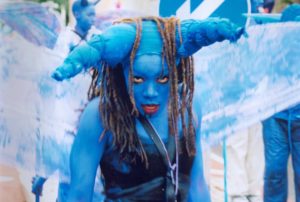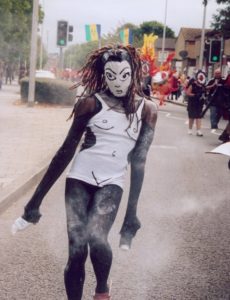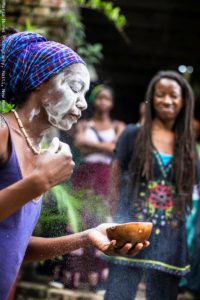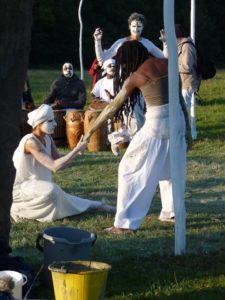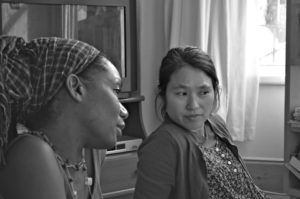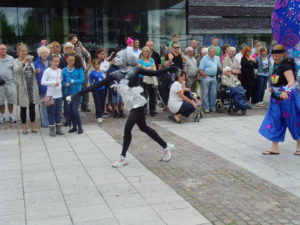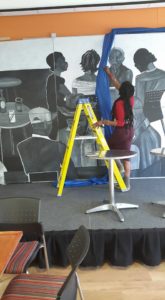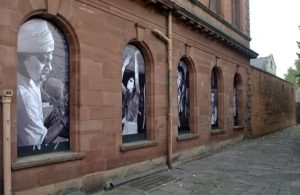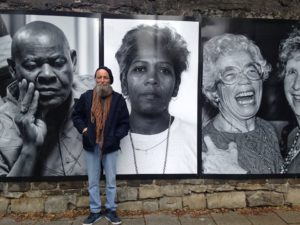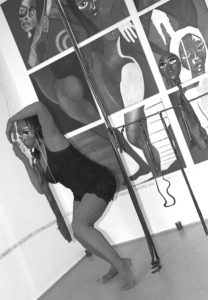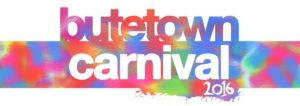Hi Adeola, You are currently a Visual Artist and Research Fellow at the University of South Wales. Is it possible to give our readers some background information on yourself?
Yes, I am actually coming to the end of my research fellowship. It was an 18 month contract with the University of South Wales and part of a large AHRC (Arts and Humanities Research Council) funded project called ‘Representing Communities.’ I am an artist, researcher, a mother of 3 boys and a Caribbean woman resident in Wales since 2003. A lot of my work is informed by my day to day experiences.
You held a President’s Award scholarship for PhD research at Cardiff University, Wales and have received several grants from the Arts Council of Wales to develop and realise collaborative arts projects. Was there a moment in your career when you knew the areas you wanted to focus on?
When I was little I wanted to be movie star! (laughs) Drawing has always been part of my life from as far back as I can remember, and dance as well. I knew I loved art and always wanted to be an artist or arts practitioner. I have very supportive parents and they really fostered my love for culture and always believed in my art, what I could do and the difference art could make to circumstances. It was during my first degree in Trinidad that I actually became convinced that I could be an artist, that I could make art and have exhibitions. My lecturers were also great examples of successful practicing artists. Being Trinidadian, Carnival was always part of my life. It was during my MA at Howard Gardens that I became interested in Carnival performance as a way of engaging the ideas of integrated arts. This Carnival interest has evolved to include ideas around re-presenting self in public spaces and what that means for social issues around notions of belonging and un-belonging, visibility and how we react to social, political, personal situations through temporary transitory performances and rituals.
You mentioned your parents I wonder if there are any individuals or organisations that helped support you in developing your skills and knowledge?
I have a long list of individuals that have helped in the development of my work but again I think the core always goes back to family – my parents, my sisters, my boys, my husband and so on. When I moved to Wales I felt in some ways as if I had to start again, to prove myself, make new contacts and forge my own little space within this art world. It was a really insecure space to be in to be honest. I joined organisations like W.I.D (Welsh Independent Dace) and C.A.D.M.A.D both of which no longer exist. S.W.I.C.A (South Wales Intercultural Community Arts) helped a lot as well, providing a space to explore and meet other artists with a range of different skills. My first solo exhibition in Cardiff was in g39 when it was on Mill Lane which was funded by the Arts Council of Wales. I feel like an ole timer now! The Butetown History & Arts Centre was also a great support to help me show my work. They too have recently lost their funding. I think the key thing though is about meeting people, travelling, experiencing, talking about your work and interests and being true to what you want to do. As part of this current research I have developed connections with the Butetown Community Centre and individuals working with and in community.
Awareness of Carnival (which you have a great deal of personal experience and knowledge in) as an art form is growing. In your opinion what is needed to help the art form develop?
That’s a great question. Carnival can be seen as a public participatory celebration of a people. It is moving and fluid and reflects issues within a society through song, dance, costume and so on. Development is a tricky word, because what does that really mean and for whom? In some regards Carnival development needs an injection of cash and government support. But I would argue that a Carnival really belongs to the people and ‘development’ could also be about handing-over and seeing what emerges over time. I am still learning about this Welsh space and I think there are carnivalesque ’emancipatory’ performances that occur in spaces like stadiums and on the streets on rugby match days. Carnival to me, becomes meaningful if the people need it. It’s tricky when it is just another fashionable purely aesthetic street parade.
You are currently focusing on first generation Caribbean migrants associated with Butetown, facilitating ideas of community re-presentation. How did this project develop and what responses have you had to date?
I have absolutely loved being a part of this project! I had the opportunity to work with Elder Caribbean migrants and to be immersed within Butetown learning about their rich history and why the space was so attractive to people travelling from the Caribbean. The project has culminated in several exhibitions including one at the Cardiff Story Museum, one in the Butetown Community Centre that includes a series of photographs of the Butetown Domino Club members by local photographer Simon Campbell.
The other end-of-project exhibition is on the Network Rail wall opposite Loudoun Square on Bute Street. It is a series of portraits by different photographers who have made Butetown a focus in their work – Simon Campbell, Keith Murrell, John Briggs and Andrew McNeill. We even managed to get a photo by Bert Hardy.
This Bute Wall exhibition looks at Butetown, the diversity, the elders and ideas of community wellbeing and representation. Generally responses have been positive.
Do you think that arts and culture in Wales represents the diversity of the citizens and communities you have worked with?
Well I think if we look closely enough we will see people representing themselves in so many ways. I think representation is crucial and the diverse fabric of Wales has been actively engaged in places like Cardiff Story Museum and Glamorgan Archives. In my experience I am not convinced that the diversity is always reflected in the visual art world but again, it is about where we look, what is made visible and what inevitably becomes less visible. But I feel positive. I think there is good work happening, a lot of talent and room for alternative ways of engaging arts.
You frequently support workshop activity with members of the public, do you think this type of activity is important and why?
Yes, I think workshops are important. As an artist working with the public opens you up to different people and conversations and experiences which as I mentioned earlier are crucial to art development and relevance. Also, I think one of the aims of art is that it is for everybody. It can challenge, inform, educate and really allow new and creative ways of seeing the everyday to emerge. Workshops are an opportunity to share art with different people and it also allows you to think about ways of making art-making/doing accessible and relevant to a diverse groupings
What are the opportunities for those interested in carnival in Wales?
Carnival is huge! There is room for everybody. First there is the question of what aspect of Carnival interests you. I know the performance department at the Atrium are starting to actively use carnival as part of their teaching. Any formal art – music, costume and set design, painting, sculpture, dance can lend itself to Carnival. The main ingredient especially with performance is not the qualification but the desire and passion to want to do it. We have the Butetown Carnival on the bank holiday weekend in August. It is a great opportunity to create and explore the potential of a Carnival in Wales. Those interested can contact Keith Murrell founder of BACA (Butetown Arts and Culture Association) at the Butetown Community Centre.
If you were in charge of funding the arts in Wales what would be your priorities?
My priority will probably be informed by spending time with different artists and communities and seeing how their visions relate to the broader political agenda for the country.
When you aren’t involved in culture or research what do you like to do in your spare time?
I feel like I am always involved in one kind of culture or another. I love spending time with my boys. I love drawing. I love dancing and laughing and learning. I also enjoy watching world cinema.
Many Thanks for your time Adeola
Thank you!

